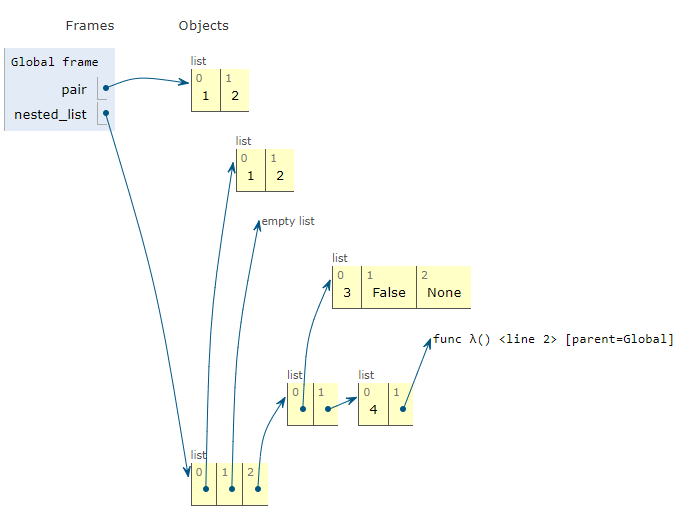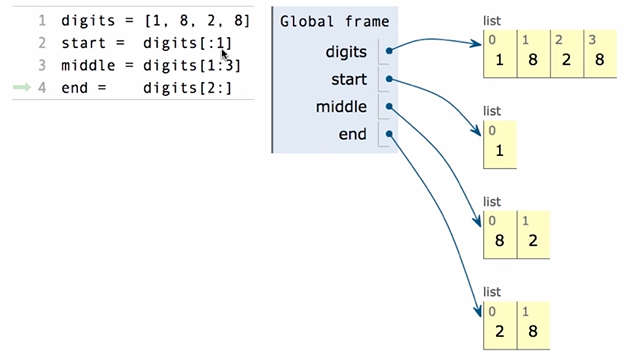Box-and-Pointer Notation
- Means of expressing lists within environmental diagrams
The Closure Property of Data types.
- Sequential data is complicated to represent.
- A method for combining data values satisfies the closure property if:
- The result of combination can itself be combined using the same method.
- Think about closure under vector addition from EECS16A, same idea of closure, just applied differently.
- Closure is powerful as we can create hierarchical structures with it.
- Every hierarchical structure is made of parts which themselves are also hierarchical structure.
- Lists may contain other lists as arguments, we need to keep track of that.
Box-and-Pointer Notation in Environment Diagrams
- In environmental diagrams, lists are represented as a row of index-labeled adjacent boxes, one per element.
- Each box contains either a primitive or a pointer to a compound value.
- A compound value can be another list, a function, or anything that has multiple parts.
1
2
pair = [1, 2]
nested_list = [[1,2], [], [[3, False, None], [4, lambda: 5]]]
Slicing
- A list operation that allows us to slice out a portion of a list based on their indicies.
1
2
3
4
5
odds = [3, 5, 7, 9, 11]
print(odds[1:3]) # I want the elements of odds with indicies in range(1,3)
print(odds[:3]) # Excluding the starting or end value implies that the start value is 0 and the end value is the last element.
print(odds[1:])
print(odds[:]) # Returns a copy of the list
1
2
3
4
[5, 7]
[3, 5, 7]
[5, 7, 9, 11]
[3, 5, 7, 9, 11]
Slicing Creates new Values
- When we make a slice of a list, a new list is produced that is separate from the original list. This means that any modifications made to the slice are not affected in the original
![List Slices]()
Processing Container Vlaues
- We may have to iterate over all of the values contained in the list or dictionary we are concerned with. There are built-in functions to help with this.
Sequence Aggregation
- Built-in functions that take a sequence and returns a single value that is the agregate of all values in that sequence.
sum(iterable[, start]) -> value- Returns the sume of an iterable of numbers, plus the value of start (default = 0). If iterable is empty, return start.
1
2
3
print(sum([2, 3, 4]))
print(sum([2, 3, 4], 5))
print(sum([[2, 3], [4]], [])) # We can also add iteratbles together
1
2
3
9
14
[2, 3, 4]
- In
print(sum([[2, 3], 4[4]], []))a default value of[]is provided instead of 0 in order to have no errors while adding the lists up. max(iterable[, key=func]) -> value- returns the maximum of the iterable, returns the largest argument with more than 1 arguments.
- A function is applied to every value we are considering, and the maximum is based on the return values of calling those functions.
1
2
3
print(max(range(5)))
print(max(0, 1, 2, 3, 4))
print(max(range(10), key=lambda x: 7-(x-4)*(x-2))) # A key is specified that applies the function to every valye of the input.
1
2
3
4
4
3
all(iterable) -> bool- Returns True if bool(x) is True for all values x in the iterable. If the iterable is empty, also return True.
- Also
minandany.
1
all([x < 5 for x in range(5)]) # Every nuber in range(5) is less than 5
1
True
Strings
- Strings are an abstraction that represents textual data.
- They represent information and language that humans may read.
- Strings may also represent a given function or line of python code, which may be executed.
1
2
3
from operator import add
exec('curry = lambda f: lambda x: lambda y: f(x, y)')
curry(add)(3)(4)
1
7
- There are three main ways of expressing string literals:
- Single quotes
'(Can use double quotes in string without termination) - Double quotes
"(Can use single quotes in string without termination) - Triple quotes
"""- May span multiple lines, used for doc strings
- Single quotes
- Other characters may be used, not just English.
- When a multi-line string is executed, line-feeds (\n) are used are used to represent every time a new line is created.
- The backslash serves to escape the following character. The backslash and the character are just one sequence that represents something.
- The length and access operations for a string are identical to that of an array’s
len(city)andcity[3]
- The
inandnot inoperators work differently for strings compared to lists- In strings, these operators check for the occurence of a substring within the string.
- This allows for us to check consecutive letters.
1
2
3
city = 'Berkeley'
print(len(city))
city[3]
1
2
8
k
Dictionaries
- Builtin Python data type.
- Contains pairs of keys and values. We use a key to look up a value.
- Written in curly braces and colons:
{<key>: <value>}
- Unlike lists, we do not look up values in dictionaries using numerical indicies, but rather with the key value.
- Key-value mapping only goes one way. Only keys are mapped to values. We cannot access the key of a value.
1
2
3
4
5
numerals = {'I': 1, 'V': 5, 'X': 10}
print("numerals:", numerals)
print("numeral for I:", numerals["I"])
print("numeral for V:", numerals["V"])
print("numeral for X:", numerals["X"])
1
2
3
4
numerals: {'I': 1, 'V': 5, 'X': 10}
numeral for I: 1
numeral for V: 5
numeral for X: 10
- Dictionaries are also sequences.
- Sequences of keys, may be displayed as a list of keys
1
2
keys = list(numerals)
keys
1
['I', 'V', 'X']
- We may also get a sequence containing all the values within the dictionary that we want.
- Use
<dictionary>.values() - This returns a
dict_valuesobject, which is unlike a list, so not all list operations apply to this new object- We may perform some operations on this, such as sum or iterating over the values.
- However, other operations, such as index subscription, is not possible with this object.
- This
dict_valuesobject may be converted to a list by using thelist()constructor.
- Use
1
2
3
4
values = numerals.values()
print(values)
for value in list(values):
print(value)
1
2
3
4
dict_values([1, 5, 10])
1
5
10
- The items within a dictionary could be arbitrarily complicated, and could also be of different types.
- The length of a dictionary refers to the number of keys that are present within the dictionary.
1
2
d = {1: ['first', 'second'], 3: 'third'}
len(values)
1
3
- A key within a dictionary can only be assigned to one value. If multiple are specified, the most recent assignment is the one that is kept:
1
{1: "first", 1: "second"}
1
{1: 'second'}
- The key of a dictionary cannot be a list or a dictionary itself. This is because these two types are unhashable. Additionally, they cannot be any mutable types
- Anything can be a value.
1
{[1]: 'first'}
1
2
3
4
5
6
7
8
9
---------------------------------------------------------------------------
TypeError Traceback (most recent call last)
Cell In[17], line 1
----> 1 {[1]: 'first'}
TypeError: unhashable type: 'list'
Overview of contraints
- A key of a dictionary cannot be a list or a dictionary (or any mutable type)
- Caused by Python’s implementation of dictionaries
- Two keys cannot be equal; There can be at most one value for a given key
- Caused by the principle of the abstraction of dictionaries
Dictoinary Comprehensions
- Compact way for creating a dictionary similar to list comprehension:
{<key expr>: <value expr> for <name> in <iter exp> if <filter exp>}
- Evaluation Process:
- Add a new frame with the current frame as the parent
- Create a new empty
result dictionarythat is the value of the expression - For each element in the iterable value of
<iter exp>:- Bind
<name>to that element in the new frame that we created - If
<filter exp>evaluates to a true value, then we add to the result dictionary an entry that pairs the value of<key expr>to the value of<value expr>
- Bind
1
{x*x : x for x in [1,2,3,4,5] if x > 2}
1
{9: 3, 16: 4, 25: 5}
Example: Indexing
- Implement
index, which takes a sequence ofkeys, a sequence ofvalues, and a two-argumentmatchfunction. It returns a dictionary fromkeysto lists in which the list for a key k contains allvaluesv for whichmatch(k, v) is a true value.
1
2
3
4
5
def index(keys, values, match):
"""Return a dictionary form keys k to a list of values v for which match(k, v) is a true value."""
return {key : [value for value in values if match(key, value)] for key in keys}
index([7, 9, 11], range(30, 50), lambda k, v: v % k == 0)
1
{7: [35, 42, 49], 9: [36, 45], 11: [33, 44]}


